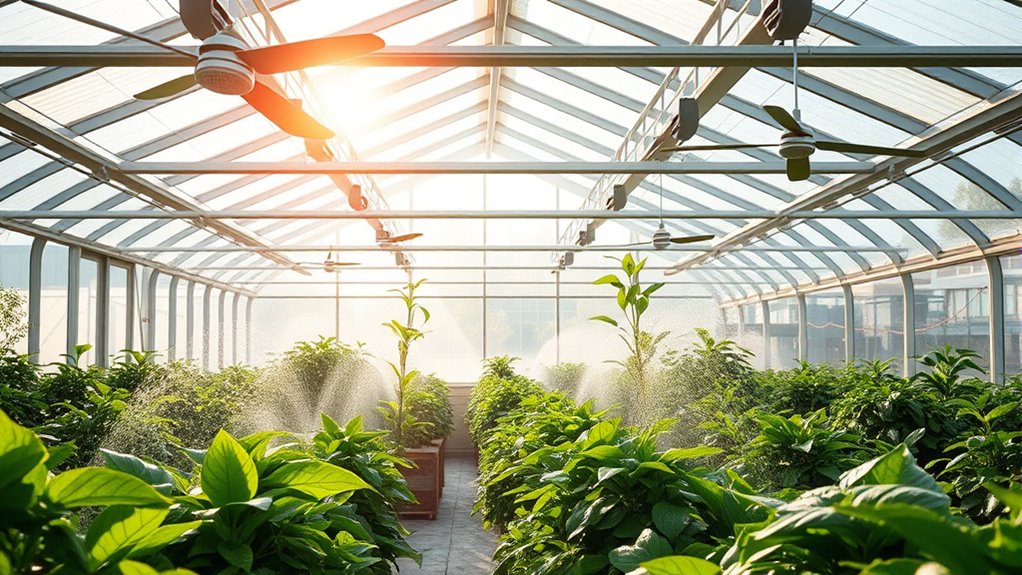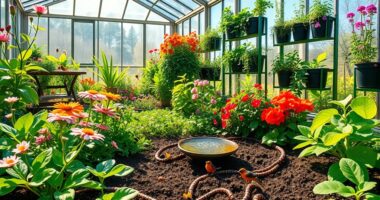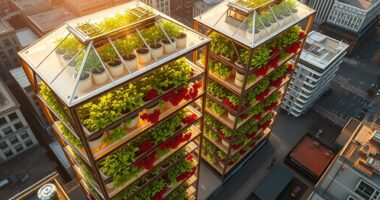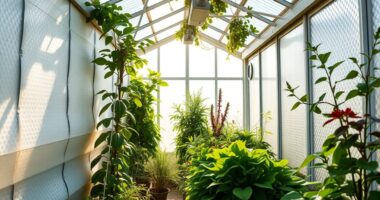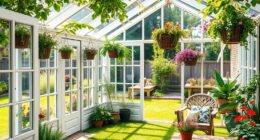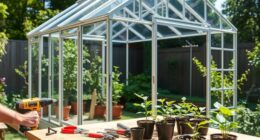I've found that having the right greenhouse cooling systems is essential for keeping your plants healthy and thriving. From the 65FT and 98FT drip irrigation kits to the effective AC Infinity Air Filtration Kit, there are plenty of options. The Misters System and VEVOR Exhaust Fan also provide great temperature control. You'll want to take into account factors like installation ease and airflow efficiency. Stick around, and you'll uncover even more fantastic systems to enhance your greenhouse!
Key Takeaways
- Drip irrigation systems like the Griinyad and HIRALIY kits efficiently cool greenhouses while conserving water through targeted moisture delivery.
- Misting systems can lower temperatures by up to 20°C, making products like the Misters System and Homenote ideal for greenhouse cooling.
- Air filtration systems, such as the AC Infinity Kit, improve air quality and temperature control, enhancing the overall climate for plant growth.
- Temperature controllers like the Inkbird ITC-308 allow for precise regulation of greenhouse environments, ensuring optimal conditions for plant health.
- User-friendly installation and maintenance features in these systems help busy gardeners set up effective cooling solutions quickly and efficiently.
65FT Drip Irrigation System Kit for Garden Watering

If you're looking for an efficient and hassle-free way to keep your greenhouse lush and thriving, the Griinyad Drip Irrigation System Kit is a fantastic choice. With its 65FT of 1/4 inch tubing and 20 mist nozzles, it covers your plants thoroughly. I love how easy it is to install, taking just 10 minutes thanks to the quick connectors. Plus, the diverse spray modes let me water exactly where it's needed. Although I've encountered some minor issues with instructions and missing components, the water conservation benefits and plant care during busy times make this system worth it for any gardener.
Best For: Gardeners looking for an efficient and time-saving irrigation solution for their outdoor spaces, including greenhouses, lawns, and vegetable gardens.
Pros:
- Easy installation with quick connectors allows setup in just 10 minutes.
- Versatile spray irrigation modes provide precise watering for various plant types.
- Supports water conservation and helps maintain plant care during busy periods.
Cons:
- Instructions may lack clarity due to poor translation.
- Some components, like the Y-shaped faucet connector and certain couplings, may be missing.
- Limited atomizing nozzles might not meet all users' needs.
AC Infinity Air Filtration Kit with Inline Fan and Carbon Filter Combo
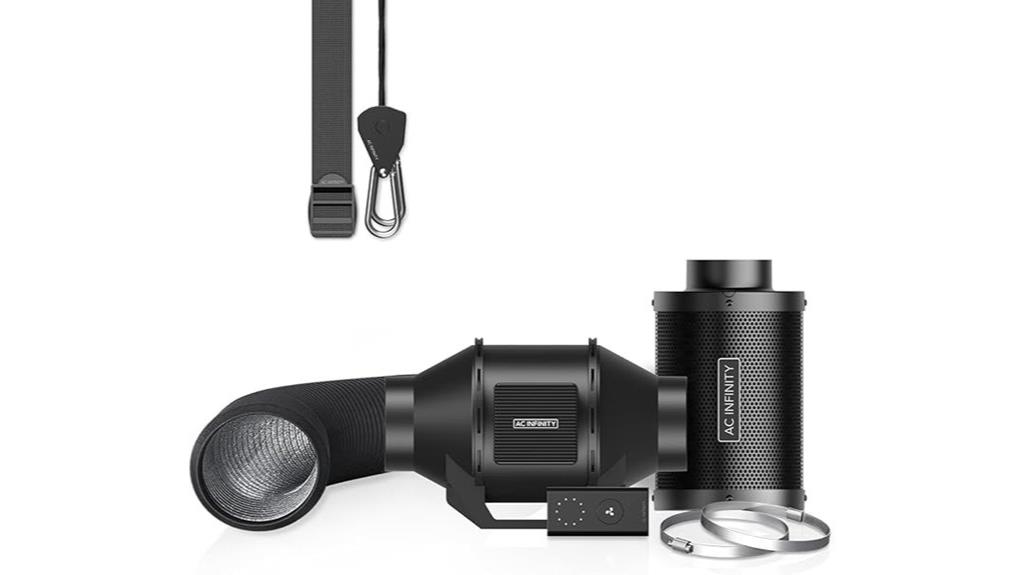
The AC Infinity Air Filtration Kit with Inline Fan and Carbon Filter Combo is perfect for serious indoor gardeners looking to maintain ideal air quality in their grow spaces. This powerful 4" kit features a CLOUDLINE LITE inline fan and a high-efficiency carbon filter that tackles odors effectively. With an impressive airflow of 165 CFM and a quiet operation at just 29 dBA, it's user-friendly too. Setting it up is straightforward, and I appreciated the smart controller for remote adjustments. If you're serious about your indoor garden, investing in this kit is a decision you won't regret.
Best For: Serious indoor gardeners seeking effective odor control and ideal air quality in their grow spaces.
Pros:
- High airflow capacity of 165 CFM ensures optimal ventilation.
- Quiet operation at 29 dBA makes it suitable for residential settings.
- Smart controller allows for remote monitoring and adjustments, enhancing user convenience.
Cons:
- The fan can be loud at full power, comparable to a window A/C unit.
- Initial confusion with controller settings may require external tutorials.
- Additional equipment may be needed for improved performance in certain setups.
98FT Drip Irrigation System Kit for Garden Watering
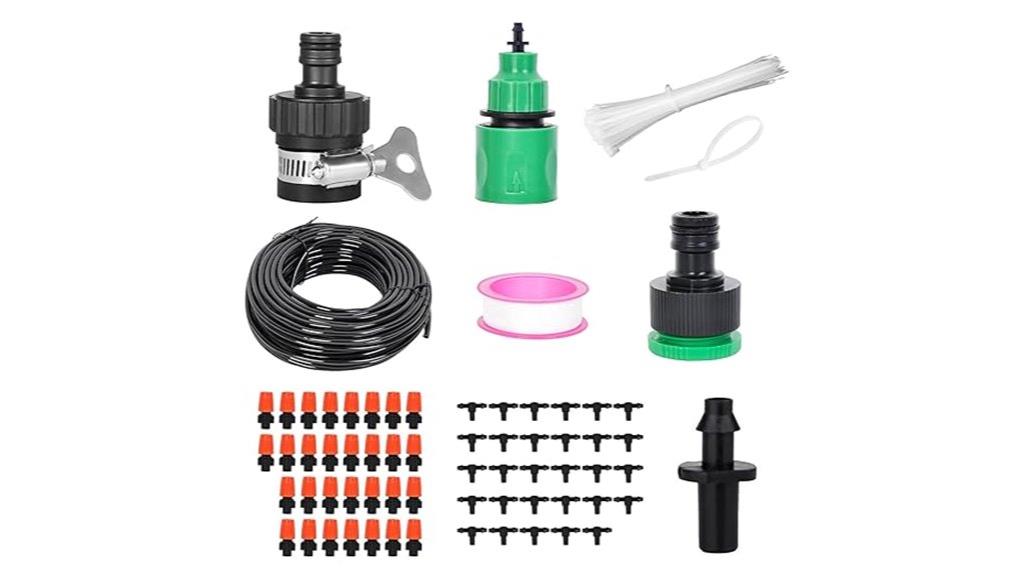
For anyone looking to simplify their garden watering process, the Griinyad Drip Irrigation System Kit is a game-changer. This complete garden watering solution comes with 98FT of 1/4 inch tubing, 30 mist nozzles, and essential connectors, making installation a breeze. I love how easy it is to set up with the advanced quick connector design, ensuring secure, leak-free connections. It efficiently distributes water across my garden, keeping everything hydrated without wasting a drop. Whether you're tending to flower beds or vegetable gardens, this system guarantees precise watering, helping my plants thrive beautifully. It's truly a must-have for any gardener!
Best For: Gardeners looking for an efficient and easy-to-install irrigation solution to keep their plants hydrated.
Pros:
- Easy installation with advanced quick connector design for secure, leak-free connections.
- Comprehensive coverage with up to 30 mist nozzles, ensuring efficient water distribution.
- Versatile application suitable for various outdoor spaces like lawns, patios, and vegetable gardens.
Cons:
- The system may require additional connectors for larger gardens beyond the provided components.
- Some users may find the 98FT tubing length insufficient for expansive outdoor areas.
- Initial setup may take time for those unfamiliar with irrigation systems.
Misters System for Outside Patio (100 FT DIY Misting Cooling System)

Looking to beat the heat while enjoying your outdoor space? I found the perfect solution with the 100 FT DIY Misting Cooling System. It includes everything you need, like 30 brass mist nozzles and various adapters for easy installation. This system produces a fine mist that can drop temperatures by up to 20℃, making it ideal for patios, gardens, and outdoor events. Plus, you can adjust the water flow for efficient watering. Maintenance is simple—just rinse the end plug monthly. With its durable design and excellent customer support, this misting system has truly transformed my outdoor experience!
Best For: Those looking to cool down and enhance their outdoor spaces, such as patios, gardens, and event areas.
Pros:
- Adjustable water flow for customized cooling and efficient watering.
- Easy installation with comprehensive accessories included.
- Durable design ensures longevity and reliable performance.
Cons:
- Monthly maintenance required for optimal misting effect.
- May require a water source nearby for proper setup.
- Initial setup time may be a consideration for some users.
VEVOR 14 Exhaust Fan with Temperature Humidity Controller
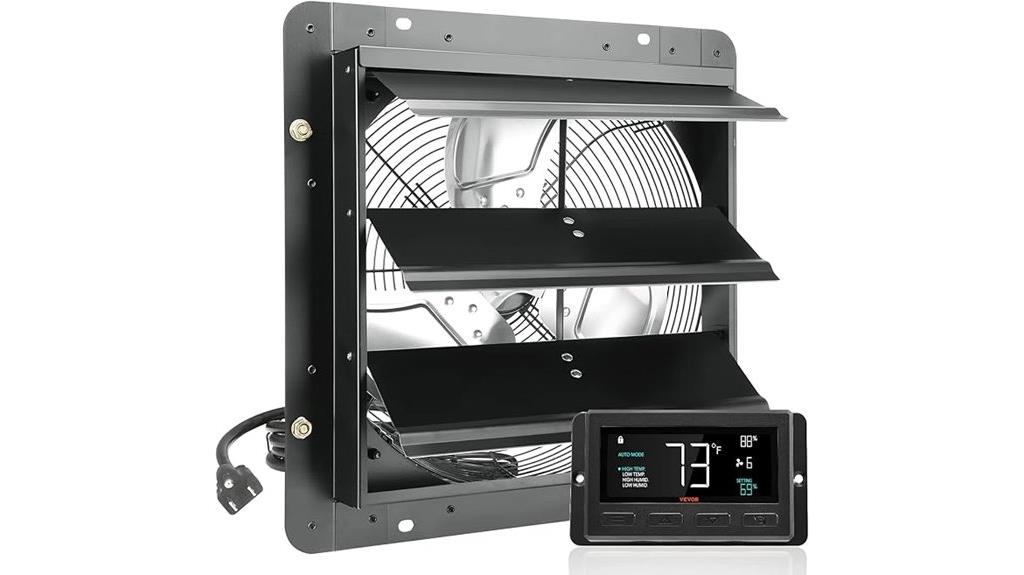
Designed with advanced features, the VEVOR 14 Exhaust Fan with Temperature Humidity Controller is perfect for greenhouse enthusiasts seeking ideal climate control. I love how its powerful EC motor delivers an impressive 1513 CFM airflow while keeping noise and power consumption low. With 10 adjustable speeds and smart programming, I can easily maintain optimal temperature and humidity levels. Its rugged, rust-proof construction guarantees durability, and the plug-and-play design makes installation a breeze. Though some users reported issues with the louvers and customer service, my experience has been largely positive. This fan keeps my plants happy and healthy!
Best For: Greenhouse enthusiasts and hobbyists looking for effective climate control solutions.
Pros:
- High airflow capacity of 1513 CFM ensures efficient heat and humidity elimination.
- Smart programming features allow for precise control over temperature and humidity levels with 10 adjustable speeds.
- Durable construction with rust-proof materials makes it suitable for various environments.
Cons:
- Some users have reported issues with louvers not functioning properly.
- Mixed experiences with customer service communication for support and warranty inquiries.
- Controller display limitations can make it difficult to monitor settings effectively.
HIRALIY Greenhouse Mist Drip Irrigation Kit

The HIRALIY Greenhouse Mist Drip Irrigation Kit stands out for its user-friendly design, making it an excellent choice for busy gardeners and greenhouse owners who want to guarantee their plants are properly hydrated without constant oversight. This kit includes a timer, 59FT of irrigation tubing, and adjustable drippers, all requiring no additional tools for setup. I love how the misting nozzles can be individually adjusted for different plants, ensuring each gets the right amount of water. Plus, the quick connector design makes assembly a breeze. Overall, it's a reliable solution for keeping my greenhouse thriving, even when I'm away.
Best For: Busy gardeners and greenhouse owners looking for an efficient, automated watering solution.
Pros:
- User-friendly design allows for easy setup without additional tools.
- Adjustable misting nozzles provide tailored watering for different plant needs.
- Quick connector design facilitates fast assembly and operation.
Cons:
- Some users report concerns about timer durability and potential water damage.
- Installation may require careful attention to ensure all components are functioning properly.
- Limited feedback on long-term performance of the system over extended periods.
Outdoor Fan Mist Cooling System Kit for Patio

For those seeking an efficient way to beat the heat in outdoor spaces, the Outdoor Fan Mist Cooling System Kit is a game-changer. This kit features a 19.6FT misting line with five metal nozzles that can cool surrounding air by up to 20 degrees. Installation takes less than 10 minutes—just attach it to your fan and connect it to a water tap. I love how it transforms any fan into an air-cooled misting fan, making it perfect for patios or pools. Plus, it's energy-efficient and uses tap water, so you won't have to worry about electricity costs.
Best For: Those looking for an affordable and efficient cooling solution for outdoor gatherings and leisure areas.
Pros:
- Excellent cooling effect, reducing temperatures by up to 20 degrees.
- Quick and easy installation in under 10 minutes.
- Energy-efficient design using only tap water, eliminating electricity costs.
Cons:
- Some users may find the mist too wet for close proximity.
- Requires a constant water supply, which may limit placement options.
- Effectiveness may vary based on fan size and outdoor conditions.
HIRALIY Greenhouse Mist Drip Irrigation Kit

If you're looking to simplify your greenhouse irrigation, the HIRALIY Greenhouse Mist Drip Irrigation Kit might be just what you need. This 59FT kit includes everything from tubing to adjustable sprinkler heads, making setup a breeze—taking only about 10 minutes! I love the quick connector system that prevents leaks, and the individual adjustments for each nozzle guarantee my plants get just the right amount of water. While some users mention nozzle performance issues, I've found it effective for various applications, including my vegetable garden. Overall, it offers great value for those wanting an automated watering solution.
Best For: Those seeking an easy-to-install and adjustable irrigation solution for their greenhouse, vegetable gardens, and urban gardening needs.
Pros:
- Easy installation with a setup time of approximately 10 minutes.
- Quick connector system that prevents leaks and ensures reliable operation.
- Adjustable sprinkler heads allow for customized watering to meet varying plant needs.
Cons:
- Some users report inconsistent nozzle performance and misting issues.
- Mixed reviews regarding durability and overall product quality.
- A few users expressed disappointment with the effectiveness in certain applications.
homenote Misting Cooling System (59FT with 20 Brass Nozzles)

Looking to beat the heat in your outdoor space? The Homenote Misting Cooling System is a game-changer. With its 59FT misting line and 20 solid brass nozzles, it efficiently cools patios, gardens, and greenhouses. I love how it maintains a comfortable 23°C, perfect for summer barbecues and lounging. Plus, it's versatile enough for watering plants and enhancing humidity. Installation is a breeze since it comes pre-assembled, though I recommend an inline water filter to keep those nozzles running smoothly. Customers rave about its cooling power and durability, making it a fantastic investment for outdoor enjoyment.
Best For: Those seeking an effective outdoor cooling solution for patios, gardens, and greenhouses during hot summer months.
Pros:
- Easy to install with pre-assembled components, saving time and effort.
- Provides significant cooling by maintaining a comfortable temperature of 23°C/73°F.
- Versatile usage for plant watering, enhancing humidity, and cooling play areas.
Cons:
- Some users report needing additional mounting supplies for optimal setup.
- Performance may be affected if not used with an inline water filter to prevent clogging.
- Limited effectiveness in extremely high temperatures without proper water pressure.
PHX Phoenix Greenhouse Heater – 220-240V Electric Heating and Cooling System

The PHX Phoenix Greenhouse Heater stands out as an excellent choice for anyone looking to maintain ideal temperatures in their greenhouse or outdoor structures. With a powerful 2800 watts and a heating capacity of 9553 BTU, it efficiently warms spaces up to 215 ft². What I love most is the adjustable thermostat that ranges from -58°F to 79°F, giving me control over my environment. Plus, it features an air circulation mode to prevent heat buildup, ensuring my plants thrive. Built with high-quality stainless steel, it's durable, waterproof, and easy to install, making it a fantastic investment for any gardener.
Best For: The PHX Phoenix Greenhouse Heater is best for gardeners and plant enthusiasts seeking a reliable heating solution for greenhouses and outdoor structures.
Pros:
- Efficient Heating: Provides powerful heating with a capacity of 9553 BTU, suitable for spaces up to 215 ft².
- Adjustable Thermostat: Offers a wide temperature range from -58°F to 79°F, allowing precise control over the environment.
- Durable Construction: Made from high-quality stainless steel and features an IPX4 waterproof rating for longevity.
Cons:
- Weight: At 11 pounds, it may be heavier than some portable heating options.
- Power Requirement: Requires a 220-240V power outlet, which may limit installation options in some locations.
- Price Point: It may be considered an investment compared to basic heating solutions available on the market.
Solar Panel Powered Fan Kit for Greenhouse

For anyone seeking an eco-friendly cooling solution, the Solar Panel Powered Fan Kit is an excellent choice for greenhouses. I love its 20W solar panel combined with a dual exhaust fan, delivering impressive airflow at 360 CFM. The fan operates quietly at 45 dB, making it ideal for maintaining a peaceful environment. Installation's a breeze with the included kit and 16FT cord. Plus, its waterproof design guarantees durability in various conditions. Just remember, it works best in sunny weather. With a solid rating of 4.3 stars, this system has proven effective for countless greenhouse enthusiasts like me!
Best For: Those looking for an eco-friendly and cost-effective cooling solution for greenhouses and outdoor spaces.
Pros:
- Easy installation with included kit and 16FT cord for flexible setup.
- Quiet operation at 45 dB, perfect for maintaining a serene environment.
- Durable waterproof design ensures longevity in various weather conditions.
Cons:
- Performance decreases significantly in cloudy weather or at night.
- Some users have reported challenges with fan direction and mounting options.
- The fan size may be smaller than expected for some applications.
Inkbird ITC-308 Digital Temperature Controller

If you're managing a greenhouse and need precise temperature control, the Inkbird ITC-308 Digital Temperature Controller is an excellent choice. It features a dual relay output, allowing you to connect both heating and cooling equipment effortlessly. The clear digital display shows measured and set temperatures simultaneously, while the user-friendly app enables remote monitoring via WiFi. I appreciate the built-in memory that retains settings during power outages. Although the probe wire is only 5 feet long, its sturdy design and reliable temperature regulation make it a must-have for any greenhouse. Overall, this controller keeps my plants happy and healthy!
Best For: The Inkbird ITC-308 Digital Temperature Controller is best for greenhouse managers seeking precise temperature control for optimal plant health.
Pros:
- Easy plug-and-play setup with intuitive programming interface for quick adjustments.
- WiFi-enabled for remote monitoring and adjustments via a user-friendly smartphone app.
- Built-in memory function retains settings during power outages, ensuring consistent operation.
Cons:
- The 5-foot probe wire may require extension cords for optimal positioning in larger setups.
- Automatic adjustments upon changing settings can lead to unintended heating or cooling actions.
- Limited logging frequency of historical data every 15 minutes may not meet all users' tracking needs.
Solar Powered Dual Fan Kit for Cooling and Ventilation

Designed specifically for small spaces, the Solar Powered Dual Fan Kit is an excellent choice for anyone looking to enhance ventilation in chicken coops, greenhouses, or pet houses. This 10W solar panel kit effectively reduces indoor temperatures with impressive airflow of 200 CFM. Installation is a breeze, thanks to the included zip ties, and it's perfect for areas up to 200 cubic feet. While it performs great in sunny conditions, keep in mind it only operates during daylight, and its efficiency can drop in partial sunlight. Overall, it's a reliable option for maintaining fresh air in confined spaces.
Best For: This product is best for individuals looking to improve ventilation and cooling in small spaces such as chicken coops, greenhouses, and pet houses.
Pros:
- Easy installation with included zip ties, making it user-friendly.
- Effective airflow of 200 CFM helps maintain fresh air and reduce indoor temperatures in sunny conditions.
- Weatherproof design protects against rain damage, ensuring durability.
Cons:
- Fans only operate during daylight and may not perform well in partial sunlight.
- Some users reported rusting and reduced airflow after several months of use.
- Limited effectiveness in larger spaces, as it is designed for areas up to 200 cubic feet.
Factors to Consider When Choosing Greenhouse Cooling Systems

When I think about choosing the right cooling system for my greenhouse, several key factors come to mind. I want to guarantee that the system is efficient and easy to install while also considering energy costs and noise levels. Plus, I need a solution that's versatile enough for different applications.
System Efficiency and Performance
Choosing the right greenhouse cooling system hinges on understanding its efficiency and performance metrics, as these factors directly impact your plants' health and your energy costs. First, look for systems with airflow ratings above 200 CFM to guarantee proper air circulation. Energy consumption is key, so aim for units that operate under 50 watts to keep operational costs manageable. I find that high-performance systems can reduce air temperatures by up to 20°C (36°F) under ideal conditions. Durability matters too; choose systems with waterproof components rated IPX4 or higher for reliability in humid environments. Finally, consider systems with smart controls that adjust automatically, potentially saving up to 30% on energy compared to manual systems.
Installation and Setup Ease
While selecting a greenhouse cooling system, ease of installation can make a significant difference in your overall experience. I always look for systems with plug-and-play designs that allow me to set them up in under 10 minutes. This saves me time and effort! Clear instructions or user manuals are essential; they guide me through the process and help avoid common mistakes. I prefer pre-assembled systems or those with quick connector designs, which guarantee secure, leak-free connections without extra tools. I also evaluate setup complexity—systems needing special mounting hardware can complicate things. Finally, I assess compatibility with my existing infrastructure, like water sources and power outlets, guaranteeing a seamless integration into my greenhouse environment.
Energy Consumption and Cost
After setting up my greenhouse cooling system with ease, I quickly turn my attention to energy consumption and cost. I notice that the energy usage can vary widely; electric fans generally consume between 30 to 120 watts. However, I'm intrigued by solar-powered systems, which can greatly lower costs after installation. To save money in the long run, I consider using energy-efficient technologies like variable speed fans. I also realize that passive cooling solutions, such as proper ventilation and shading, are cheaper than active systems like air conditioning. Regular maintenance is essential, as well-maintained systems perform better and use less energy. I find that monitoring external conditions helps optimize cooling, ensuring it runs only when necessary.
Noise Level Considerations
When I consider the right cooling system for my greenhouse, noise level becomes an important factor. I've learned that noise levels can vary greatly—some fans operate as quietly as 29 dBA, akin to a quiet library, while others can be as loud as a window air conditioning unit. When choosing, I always check the decibel ratings; systems under 40 dBA are labeled as quiet and are perfect for noise-sensitive areas. I also appreciate fans with multiple speed settings, which allow me to run them at lower speeds when I need a quieter environment. The design and quality of the motors can also make a big difference in noise generation, ensuring a peaceful atmosphere for both my plants and nearby residents.
Versatility of Applications
Choosing the right cooling system goes beyond just noise levels; versatility in applications is equally important. I've found that greenhouse cooling systems can be used in various settings, from residential greenhouses to commercial farms and even indoor gardening setups. Some systems not only ventilate but also enhance air circulation in sheds, garages, and workshops, reducing heat buildup. I love that many solutions serve dual purposes, functioning as humidifiers while filtering dust and airborne particles. Plus, versatile systems can adapt to outdoor spaces like patios and backyards, making them great for gatherings. A well-designed cooling system can also improve the efficiency of other gardening equipment, ensuring the ideal microclimate for thriving plants.
Durability and Material Quality
While I consider various aspects of greenhouse cooling systems, durability and material quality stand out as essential factors. I always look for systems made of rust-proof and weather-resistant materials like stainless steel or high-quality plastics. These materials can handle the diverse environmental conditions we face in our greenhouses. A high IP rating, such as IPX4 or IPX7, also catches my eye, as it offers better protection against moisture and dust, ensuring longevity. I prefer fans and components crafted from heavy-duty materials since they resist wear and tear, providing reliable operation when it's needed most. Plus, high-quality construction not only extends the system's lifespan but also boosts energy efficiency, ultimately saving on costs.
Maintenance and Upkeep Needs
Understanding the maintenance and upkeep needs of greenhouse cooling systems is essential for guaranteeing their long-term performance and efficiency. I've found that regular maintenance is key—cleaning filters, checking for clogs in misting nozzles, and confirming water lines are debris-free can prevent system failures. Don't overlook electrical components; periodic inspections help maintain safe operations. Seasonal checks are also important, especially after extreme weather, to identify wear on hoses, fans, and pumps. I recommend testing and calibrating thermostats regularly to verify accurate temperature control, which is critical for plant health. Finally, monitoring water quality by checking pH levels and using inline filters can enhance misting system performance, reducing clogging risks and boosting efficiency in the long run.
Environmental Impact Assessment
After ensuring your greenhouse cooling systems are well-maintained, it's time to evaluate their environmental impact. I focus on energy consumption and greenhouse gas emissions, as these can vary between electric and solar-powered systems. Opting for renewable energy sources, like solar panels, can greatly reduce your carbon footprint by minimizing fossil fuel reliance. I also consider water use efficiency; cooling systems that employ misting should effectively cool while wasting as little water as possible. Material selection matters too—choosing products made from recycled or eco-friendly materials can lower environmental impact. Finally, I conduct lifecycle assessments to understand overall effects during manufacturing, operation, and disposal, ensuring I choose the most sustainable options for my greenhouse.
Frequently Asked Questions
What Are the Benefits of Using a Greenhouse Cooling System?
I've found that using a greenhouse cooling system offers numerous benefits. It helps maintain a consistent temperature, which is essential for plant growth. I've noticed that my plants thrive better when they're not subjected to extreme heat. Cooling systems also improve air circulation, reducing humidity levels that can lead to diseases. Plus, I can extend the growing season, allowing me to enjoy more bountiful harvests throughout the year.
How Do I Maintain My Greenhouse Cooling System?
You know, I once thought maintaining my cooling system was a hassle, but it turned out to be quite straightforward. I regularly check the fans and filters, ensuring they're clean and free of debris. I also monitor the thermostat settings and adjust them when needed. Periodically, I inspect the water supply lines for leaks. Keeping a schedule for these tasks has really helped me stay on top of things and keep my greenhouse thriving!
Can I Use Multiple Cooling Systems Together?
Absolutely, I've found that using multiple cooling systems together can be really effective. Combining fans with evaporative coolers, for instance, helps circulate air better and lowers the temperature more efficiently. I've noticed that when I layer these systems, my plants thrive even in the heat. Just make sure to monitor humidity levels, as too much moisture can lead to other issues. It's all about finding the right balance for your space!
What Is the Ideal Temperature for Greenhouse Plants?
Finding the sweet spot in temperature is like striking a perfect chord in music. I've discovered that most greenhouse plants thrive best between 70°F and 80°F during the day and slightly cooler at night. This range keeps my plants vibrant and productive. However, it's essential to take into account specific plant needs, as some may prefer slightly different conditions. Keeping an eye on temperature guarantees a harmonious environment for my green friends to flourish!
How Do I Choose the Right Size Cooling System for My Greenhouse?
When I'm choosing the right size cooling system for my greenhouse, I consider its dimensions and the plants I'm growing. I measure the square footage and account for factors like insulation and sunlight exposure. Typically, I aim for about 20 BTUs per square foot. Also, I think about the peak temperatures I experience; those hot days can really impact my plants. Balancing these factors helps me make the best decision for my greenhouse.
Conclusion
As the sun blazes overhead and your plants wilt under the relentless heat, imagine the cool breeze of a well-placed fan or the invigorating mist from a perfect irrigation system. Choosing the right cooling system isn't just about comfort—it's about survival. Picture your vibrant, thriving greenhouse, flourishing with life. Don't let the heat win; take charge and transform your space into a sanctuary. What will you choose to keep your plants happy and healthy? The answer awaits.
